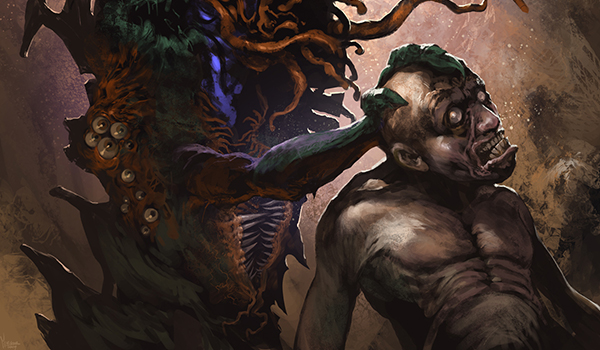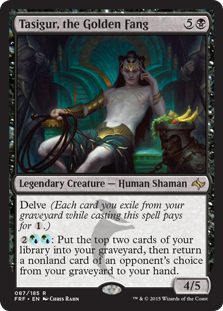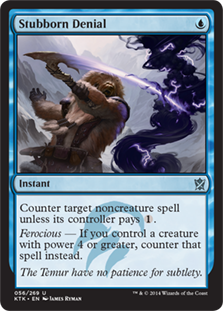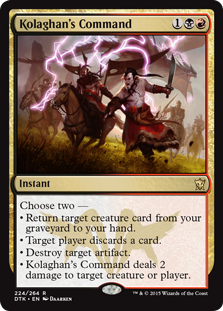Are you a Quiet Speculation member?
If not, now is a perfect time to join up! Our powerful tools, breaking-news analysis, and exclusive Discord channel will make sure you stay up to date and ahead of the curve.
This past week I found myself looking back at some of the first articles I wrote here at Nexus, for some reason or another, and discovered something interesting about my writing. No, it’s not that I love control, or have a tendency to play tempo-oriented decks, or really really like to talk about context in Magic, though all of that is of course true. Interestingly enough, I haven’t done many primers in my life (or at least my Magic content career), which both surprised me and made complete sense at the same time, if that’s possible. It might come from my firm belief that sideboarding should be a fluid process, and part of me feels that primers tend to fall into the "basic level info" camp for a format where most players learn the intricacies of one deck and tend not to switch, but I just haven’t felt the draw to that style of writing compared to other topics I’ve explored.

Still, something in me felt the desire to branch out a little bit. Looking back at my content, I discovered that my old Video Series were, in a sense, brief primers I used to do on a weekly basis. In the lull period between a potentially outdated format and one where Ixalan is out in full force, it seemed like the perfect time to try my hand at something new(old). Since I also noticed that my first article was on Grixis Control, and my second article was on Suicide Zoo, it seems fitting (and perhaps overdue) that this primer be on Grixis Death’s Shadow.
Cue the audible groans! See, I can imagine most of you already aren’t too excited about an article all about Grixis Death’s Shadow, and I get it. Nobody likes paying their taxes either. On one hand, some of you are Grixis players yourselves, which means most of the content here might be information you might already know. For the rest of you, you’re probably tired of seeing Grixis Death’s Shadow in matches at this point, so the mere thought of reading about the deck probably inspires nightmares of painful fingernail extraction while Justin Bieber prunes his facial hair in your direct line of vision.
Therein lies the rub. I’m banking on the assumption that you’re a diligent, tax-paying, law-abiding citizen: one that takes their licks when they're given; one that grits his teeth and puts his nose to the grindstone, doing the dirty work that needs to be done to achieve everlasting success and a better life for generations to come. It’s not glamorous. It’s not sexy. It’s the inner workings of Grixis Death’s Shadow, how it runs, and how to beat it.
The Basics
Grixis Death’s Shadow, at its core, is a resource-driven value engine that combines disruption and cheap threats in a synergistic package with game against just about everything. So, basically, a sickening package of aggression, value, and flexibility. Shadow decks are hard to fight because they are hard to pin down, and can pivot and adapt to just about any role or situation it's required to take in a given matchup. As evidenced by its long history in Modern, Death’s Shadow is cheap, fast, and powerful enough to make it difficult to race or fight fair, and going unfair plays right into the disruption game Death’s Shadow decks can play so well.
 The core revolves around eight (sometimes one more or fewer) cheap threats, in the form of Death's Shadow itself and delve creatures like Tasigur, the Golden Fang and Gurmag Angler. I say "cheap" in the sense that both creatures carry restrictions regarding when they can be played, with Death's Shadow requiring us to drop below a certain life threshold and delve creatures requiring cards in the graveyard to pay their exorbitant mana costs.
The core revolves around eight (sometimes one more or fewer) cheap threats, in the form of Death's Shadow itself and delve creatures like Tasigur, the Golden Fang and Gurmag Angler. I say "cheap" in the sense that both creatures carry restrictions regarding when they can be played, with Death's Shadow requiring us to drop below a certain life threshold and delve creatures requiring cards in the graveyard to pay their exorbitant mana costs.
This is basic info, of course, but it’s important to put into words because this oft-overlooked fact is one of the few ways to fight the deck. For all its strengths, eight threats is a very low number if we can stop them on the way down. By that, I mean removing the recursion engine of Kolaghan's Command chained with Snapcaster Mage, or taking away the graveyard as a resource to cast the delve spells. Cards like Surgical Extraction to take away all Death's Shadows immediately halves the threats Grixis has to deploy, and bombs like Leyline of the Void can shut down the deck's engine entirely.
The Rest
Beyond the self-explanatory cards like Serum Visions, Thought Scour, and Street Wraith, Grixis Death’s Shadow employs a midrange value package, disruption, removal, and protection in varying numbers. We’ll take them one at a time, and discuss briefly what these cards do for the strategy.
 First up is proactive disruption, which usually takes the form of six or seven one cost discard spells like Thoughtseize and Inquisition of Kozilek. Grixis Death’s Shadow tends to play threats for one mana, but almost never on the first turn, which allows them to take advantage of targeted discard as a form of disruption that can be used for both offense and defense. Stripping a removal spell that could answer Death's Shadow can often be all that’s needed to win, as our creatures hit so hard, and removing opposing threats can give us time to get our engine going or dig for threats should we be missing them in hand.
First up is proactive disruption, which usually takes the form of six or seven one cost discard spells like Thoughtseize and Inquisition of Kozilek. Grixis Death’s Shadow tends to play threats for one mana, but almost never on the first turn, which allows them to take advantage of targeted discard as a form of disruption that can be used for both offense and defense. Stripping a removal spell that could answer Death's Shadow can often be all that’s needed to win, as our creatures hit so hard, and removing opposing threats can give us time to get our engine going or dig for threats should we be missing them in hand.
Trading a card in hand and a resource for a card in our opponent’s hand often puts us at a disadvantage as far as rate is concerned, in the sense that we are exchanging an ‘even’ effect (both players losing a card from hand) but we are spending a resource (one mana) and our opponent is not. This fact, again something that might be basic info, still gives a clue towards a weakness of the deck, which is that it leans heavily on using that first turn to push its opponent off their game and give it time to bring its engine online. Quick, aggressive strategies that can make discard a liability, in the sense that sometimes the Death’s Shadow player can’t afford to spend a resource on something that doesn’t interact with the board. A quick start from the enemy can knock the archetype out of its lane and put it on the back foot.
 This notion of playing on the "back foot," or on defense, is one that players might remember from the days of tempo-aggro, epitomized by Delver of Secrets decks. Delver decks always experienced a wide discrepancy in terms of power level depending on whether those archetypes had their namesake card in play or not. Tempo-generating spells like Vapor Snag and Spell Pierce gain value when the opponent is forced to play into them, which happens most often when we have a creature out applying pressure. In the same way, Death’s Shadow decks rely on playing and keeping a threat on the field; otherwise, Stubborn Denial becomes useless, and discard in high numbers becomes a liability in the lategame.
This notion of playing on the "back foot," or on defense, is one that players might remember from the days of tempo-aggro, epitomized by Delver of Secrets decks. Delver decks always experienced a wide discrepancy in terms of power level depending on whether those archetypes had their namesake card in play or not. Tempo-generating spells like Vapor Snag and Spell Pierce gain value when the opponent is forced to play into them, which happens most often when we have a creature out applying pressure. In the same way, Death’s Shadow decks rely on playing and keeping a threat on the field; otherwise, Stubborn Denial becomes useless, and discard in high numbers becomes a liability in the lategame.
Unfortunately for the field, Grixis Death’s Shadow plays like a supercharged Delver deck, in the sense that we turned our Spell Pierce into a (relatively) unconditional counterspell in Stubborn Denial, and traded our 1/1 that sometimes became a 3/2 flier for a 4/5, or an X/X that sometimes grows into 8/8 or larger. This is what those of us in the business call power creep, boys and girls.
 When our threats hit so hard, Stubborn Denial to gain us another turn of uninterrupted combat phases becomes that much more powerful, and recursion effects like Kolaghan's Command get compounded as well. The power level of just about everything gets ramped up when we improve our core threat base, which is why Delver of Secrets decks could never make that final push into the top tier while Death’s Shadow decks could, even though they play most of the same cards.
When our threats hit so hard, Stubborn Denial to gain us another turn of uninterrupted combat phases becomes that much more powerful, and recursion effects like Kolaghan's Command get compounded as well. The power level of just about everything gets ramped up when we improve our core threat base, which is why Delver of Secrets decks could never make that final push into the top tier while Death’s Shadow decks could, even though they play most of the same cards.
As for the sideboard, I hesitate to give too much information, as I'm a firm believer in personalized sideboards that fit the player, and not the deck. Besides, with how quickly things can move in Modern (looking at you, Geist of Saint Traft), including sideboard information in a primer that hopes to remain a reference for the future seems presumptuous at best, and dangerous at worst. Who knows what the meta will look like two months, or even two weeks from now? Probably a lot like this one, but my point remains!
Conclusion
This might not have read like a traditional primer, which was actually by design. Hopefully, my experiment was successful, and this primer successfully discusses how a deck is built, how it works, and how best to attack it, while dodging the traditional “these are the creatures, these are the draw spells, this is the sideboard” method in which primers are usually written. If you liked this approach, let me know in the comments below, and I can expand to other decks in the format in a similar manner. If you didn’t like this approach, obviously let me know as well, so I can work to improve in the future! Primers are a tool in my repertoire that haven’t gotten much use, and I plan for that to change moving forward, but with a signature twist, of course. Thanks for reading, and I’ll see you next week!
Trevor Holmes
The_Architect on MTGO






Hi Trevor,
I thought this article was interesting. I wouldn’t call it a primer as much as I would call it a theoretical treatise on how Grixis Death’s Shadow works, and why it’s effective. It was definitely a refreshing read, though, and I’d like to see you expand it to other decks in the metagame.
I’ve found that despite the deck having an almost ‘boogeyman’ level of impact on the hearts and minds of modern players, I haven’t really seen all that much in the way of articles or videos since the deck played in Jund colours.
I found this article and its approach quite refreshing actually, and i’d like to see articles of this type covering all the decks in modern, as a helpful resource for those players looking to know more about the format.
Thanks for this one. It can’t have been easy to decide to write about this deck, but I feel it was worth it.
(that said, I don’t feel like you needed to excuse yourself or apologise at the beginning. That may have been hamming it up slightly, because the quality of the article is sound. A ‘primer’ it may not strictly be, but it was insightful and enjoyable all the same)